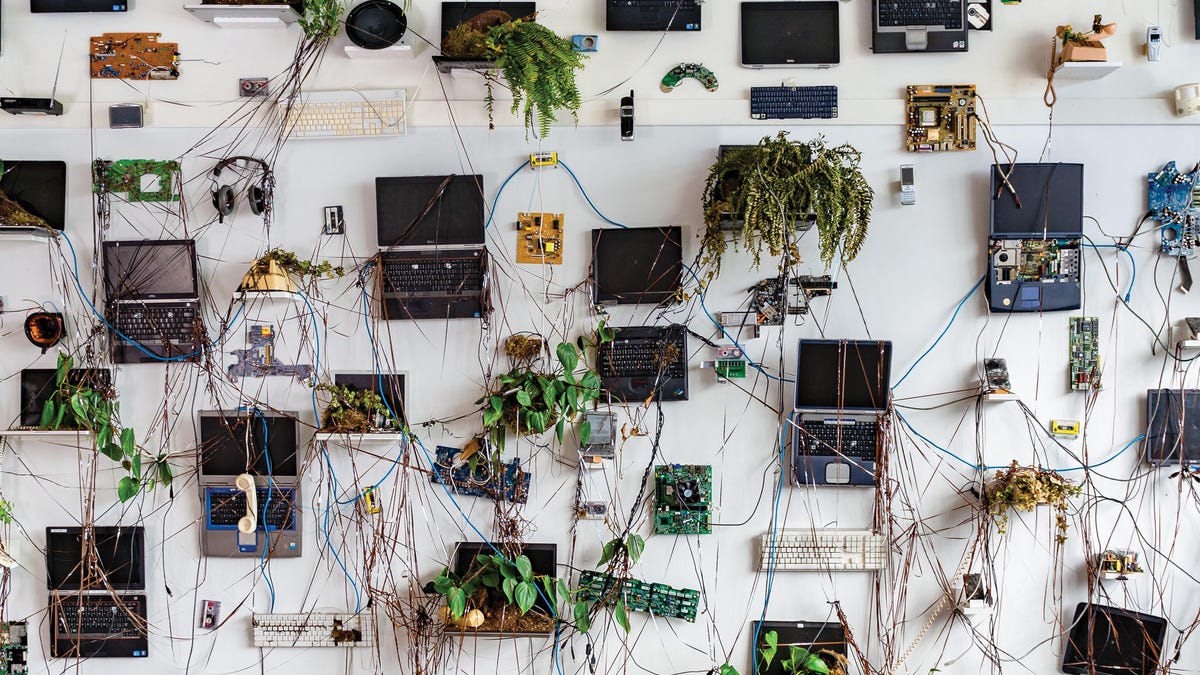 Why You Can Trust CNET
Why You Can Trust CNET Your phone in a million years: When electronics outlive humans
Visit Nathaniel Stern's "The World After Us," a strange and provocative place.

For the "The Wall of Us," laptops, keyboards, drives, phones, circuits and other electronic waste clings to and climbs up the wall to create a sense of what we use and throw out.
Nathaniel Stern has spent the last few years torturing consumer electronics. Burning them. Freezing them. Smashing them. He's not a gadget sadist. He's an artist and engineer imagining what today's devices might look far, far down the line.
Like a million years from now.
The gadget torment started when Stern, a professor of both art and design and engineering at the University of Wisconsin-Milwaukee, looked down at his iPhone in its hard, plastic case and found himself pondering the product's future -- not from a design perspective, but from an ecological one. How, exactly, would the phone disintegrate over time? Would that plastic ever decompose?
Mobile phones and other devices subjected to extreme heat and pressure became "Phossils."
Those questions led him to expose a series of devices to extreme conditions, like high temperatures and pressure, that mimicked the ravages of time. These "Phossils" (fossilized phones ) will be on display as part of The World After Us: Imaging techno-aesthetic futures, a traveling solo exhibit of sculptures, installations, prints and photographs aimed at provoking a conversation about technology use and waste.
"The World After Usis not post-apocalyptic," reads a description of the project. "Rather, it imagines potential futures while asking viewers to be mindful of their media in the present."
The exhibit takes inspiration from Alan Weissman's book The World Without Us, which asks what the world might look like when humans have been replaced by other forms of biological life. The exhibit premieres Jan. 17 at the Museum of Wisconsin Art, which calls it a "timely provocation that will leave viewers contemplating how we might change our ecological trajectory."
A drive, tortured for art.
Exhibit visitors will encounter a wall climbing with moldy laptops , keyboards, drives, phones and other degraded e-waste sprouting and tangled in botanicals. The green vines and electrical cords intertwine to form a strange jungle. Also on display are a live water fountain that cracks and peels the glass off a different iPhone over the course of each show, and a flipping hourglass that sands down a phone every 60 minutes.
Viewers will also find examples of gadgets given new life.
"We should not only ask what digital media will be and do, after us," the artist's description reads. "We must reinvent what digital waste can be and do, in the present."
There are fine-art prints of mobile devices drawn from ink made up of phones ground into a fine powder. On closer inspection, the newfangled ink sparkles with bits of embedded metal and shards of glass. Melted aluminum iMacs from the late 2000s have been shaped into a hammer, screwdriver and wrench. Routed circuit boards have been reborn as a saw, ax and trowel.
For "Circuitous tools," part of Nathaniel Stern's exhibit The World Without Us, routed circuit boards have been reborn as a saw, ax and trowel.
Stern estimates that the exhibit encompasses about 250 computers, 100 phones and a few dozen keyboards and mice, plus hundreds of feet of audiotape and ethernet and USB cables.
Artist Nathaniel Stern started wondering about the future of his phone.
The goods were culled from second-hand electronics stores and local e-waste surplus operations, as well as companies that had heard about the project and donated their discarded electronics. The artist says he and his team will recycle much of the art after the exhibit makes its rounds.
Stern, who has widely exhibited his work internationally, often focuses on how people engage with and experience the world.
Past projects have involved him hitching a flat-bed desktop scanner, computing device and custom battery pack to his body and swinging over flowers or jumping over bricks to capture images of objects and spaces. He also went underwater with custom DIY photography rigs toggled from custom electronics to image the mysterious deep-sea world. Because Stern wore the devices, his movements helped compose the shots.
Stern says viewers have called this latest project, his most ambitious to date, "intense yet hopeful, sad and beautiful, all-consuming around our consumption." Some have said it scares them. But, he says, "Everyone agrees on one thing. It is a call to action."

